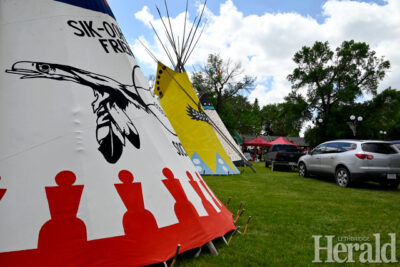Lethbridge Herald, July 11, 2024.

 A tepee was set up in Galt Gardens on National Indigenous Peoples Day last month. Outreach workers in the midst of the drug crisis say a return to culture can have a big impact on Indigenous people struggling with addiction. Photo by Justin Sibbett for the Herald
A tepee was set up in Galt Gardens on National Indigenous Peoples Day last month. Outreach workers in the midst of the drug crisis say a return to culture can have a big impact on Indigenous people struggling with addiction. Photo by Justin Sibbett for the HeraldEditor’s note: This is the second of a three-part series looking at southern Alberta’s opioid crisis from an Indigenous perspective.
Alexandra Noade – Lethbridge Herald – Local Journalism Initiative Reporter
The last residential school in Canada closed in 1996. These schools were just one of many attempts by the Canadian government to assimilate Indigenous people.
These attempts have left many Indigenous people feeling lost and disoriented, with no sense of identity.
Rachel Bush was adopted by a white family as a baby. It wasn’t until she reunited with her biological mother as an adult that she realized she was Native American. As a teenager, Bush found herself in a vulnerable position, but the birth of her daughter helped her break free.
“I watched some of the people I was close to in high school get addicted to stuff, so it was hard to watch. And then I had to be smarter after I had my daughter, so I’m really glad it never got to something more serious than alcohol,” Bush said.
Bush said she’s had to work hard on herself to avoid passing on intergenerational trauma to her daughter, and despite her desire to reconnect with her culture, she struggled to find the right resources.
“My biological mother isn’t that interested in our culture, so it’s hard to learn as much from her and to try to learn as much as I can from my ancestors. It’s hard to connect as much as I would like because we all live so far apart and have different lifestyles,” Bush said.
Leslie Wells, Blood Tribe’s drug response coordinator, also experienced addiction but was able to recover with the help of leaders from her culture.
“I’m a person with lived experience in all aspects, from past trauma to addiction and everything in between, and it was really nice to be able to turn to support services. What really helped me was my culture, the support and the support from my elders. It was really empowering,” Wells said.
“That’s what it feels like when you’re in the midst of our culture. When you participate in the ceremonies, you feel hopeful. You start to feel healing and you feel balanced with yourself, mentally, physically and emotionally. Our culture provides just that, and in turn it gives you hope, it restores your identity and a strong sense of belonging to the Creator and the land,” Wells said.
Former Blood Tribe chief, Weaselhead, Grand Chief of Treaty 7, has worked for years to help people struggling with addiction caused by intergenerational trauma. He said reconnecting with culture has a big impact on Indigenous people struggling with addiction.
“I think that in those early years, our community was unable to recapture the cultural values that we see today as some of the most important components of addiction and training,” Weaselhead said.
“I’m really, really happy to see our people coming back as time goes on. You know, the spiritual side of healing is one of the most natural ways to heal our people and we’re starting to see our people starting to go back to our foundations in terms of our traditions and culture,” Weaselhead said.
Piikani Chief Troy “Bossman” Knowlton said he hopes sharing his experience overcoming addiction by returning to Blackfoot culture will inspire others to follow suit.
“I always talk about the ceremonial part of it, how it changed my life, how it was the right thing to do for me and all of the Blackfoot people, and the opportunity it gives us all if we choose to live it that way,” Knowlton said.
Wells echoed the same sentiment, saying the Blackfoot people welcome those in need with open arms.
“The hardest part was asking for help, but once I got through that and was able to ask for help, everyone was so welcoming. As Indigenous people, we are very collective and we work together. We are all accepting of everything. So once we knew our culture was accepted, the ceremony and everything just happened naturally. It’s in our DNA. It’s not lost in our DNA, but it’s lost because we’ve had so much trauma and it’s been repressed.”
19
-18

